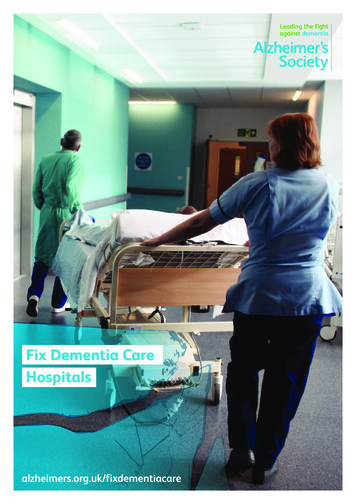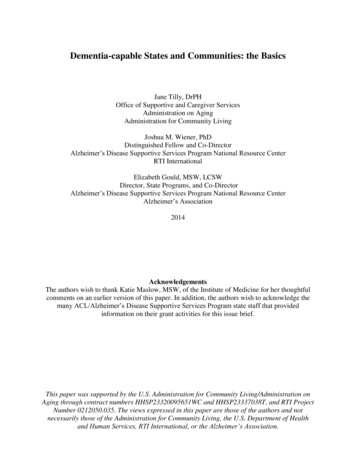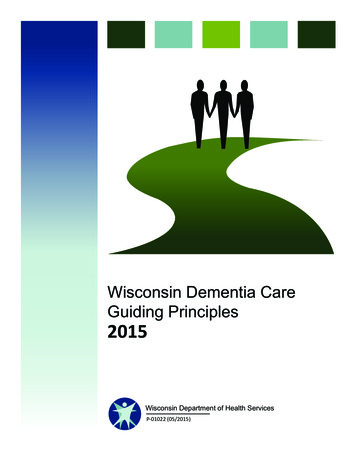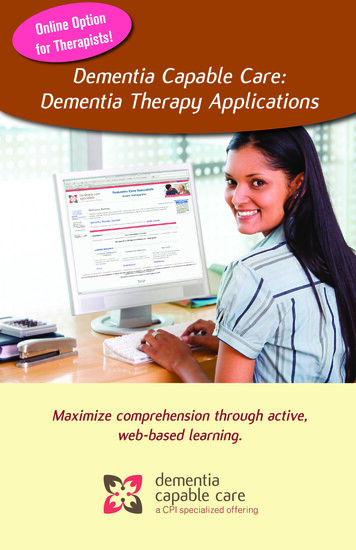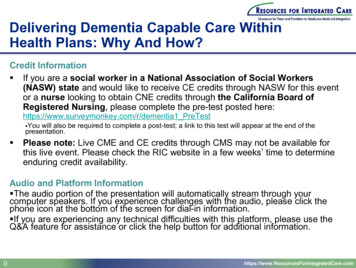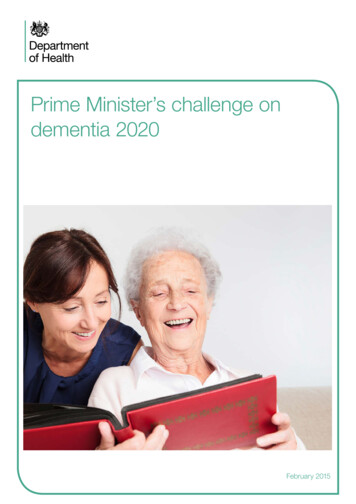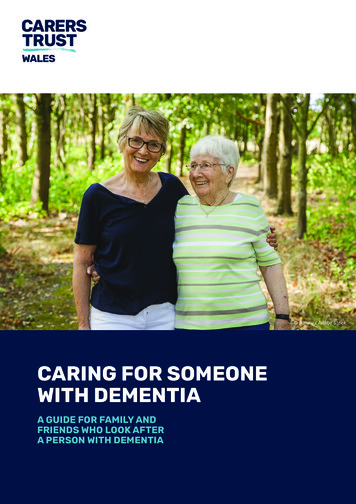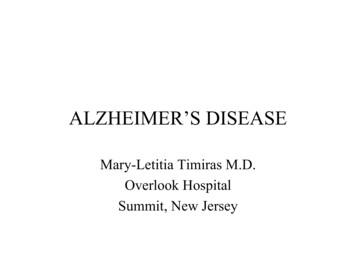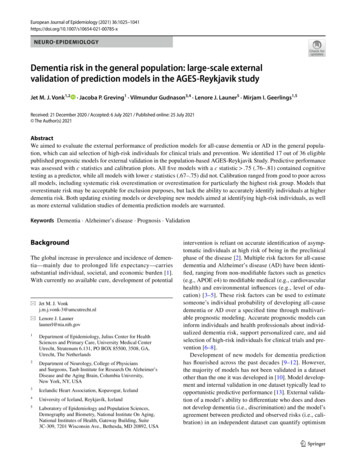
Transcription
European Journal of Epidemiology (2021) 0785-xNEURO-EPIDEMIOLOGYDementia risk in the general population: large‑scale externalvalidation of prediction models in the AGES‑Reykjavik studyJet M. J. Vonk1,2· Jacoba P. Greving1 · Vilmundur Gudnason3,4 · Lenore J. Launer5 · Mirjam I. Geerlings1,5Received: 21 December 2020 / Accepted: 6 July 2021 / Published online: 25 July 2021 The Author(s) 2021AbstractWe aimed to evaluate the external performance of prediction models for all-cause dementia or AD in the general population, which can aid selection of high-risk individuals for clinical trials and prevention. We identified 17 out of 36 eligiblepublished prognostic models for external validation in the population-based AGES-Reykjavik Study. Predictive performancewas assessed with c statistics and calibration plots. All five models with a c statistic .75 (.76–.81) contained cognitivetesting as a predictor, while all models with lower c statistics (.67–.75) did not. Calibration ranged from good to poor acrossall models, including systematic risk overestimation or overestimation for particularly the highest risk group. Models thatoverestimate risk may be acceptable for exclusion purposes, but lack the ability to accurately identify individuals at higherdementia risk. Both updating existing models or developing new models aimed at identifying high-risk individuals, as wellas more external validation studies of dementia prediction models are warranted.Keywords Dementia · Alzheimer’s disease · Prognosis · ValidationBackgroundThe global increase in prevalence and incidence of dementia—mainly due to prolonged life expectancy—carriessubstantial individual, societal, and economic burden [1].With currently no available cure, development of potential* Jet M. J. Vonkj.m.j.vonk-3@umcutrecht.nl* Lenore J. Launerlaunerl@nia.nih.gov1Department of Epidemiology, Julius Center for HealthSciences and Primary Care, University Medical CenterUtrecht, Stratenum 6.131, PO BOX 85500, 3508, GA,Utrecht, The Netherlands2Department of Neurology, College of Physiciansand Surgeons, Taub Institute for Research On Alzheimer’sDisease and the Aging Brain, Columbia University,New York, NY, USA3Icelandic Heart Association, Kopavogur, Iceland4University of Iceland, Reykjavík, Iceland5Laboratory of Epidemiology and Population Sciences,Demography and Biometry, National Institute On Aging,National Institutes of Health, Gateway Building, Suite3C‑309, 7201 Wisconsin Ave., Bethesda, MD 20892, USAintervention is reliant on accurate identification of asymptomatic individuals at high risk of being in the preclinicalphase of the disease [2]. Multiple risk factors for all-causedementia and Alzheimer’s disease (AD) have been identified, ranging from non-modifiable factors such as genetics(e.g., APOE e4) to modifiable medical (e.g., cardiovascularhealth) and environmental influences (e.g., level of education) [3–5]. These risk factors can be used to estimatesomeone’s individual probability of developing all-causedementia or AD over a specified time through multivariable prognostic modeling. Accurate prognostic models caninform individuals and health professionals about individualized dementia risk, support personalized care, and aidselection of high-risk individuals for clinical trials and prevention [6–8].Development of new models for dementia predictionhas flourished across the past decades [9–12]. However,the majority of models has not been validated in a datasetother than the one it was developed in [10]. Model development and internal validation in one dataset typically lead toopportunistic predictive performance [13]. External validation of a model’s ability to differentiate who does and doesnot develop dementia (i.e., discrimination) and the model’sagreement between predicted and observed risks (i.e., calibration) in an independent dataset can quantify optimism13Vol.:(0123456789)
1026due to overfitting or statistical modeling limitations [13].Moreover, evaluating predictive models in another setting(e.g., health care, geographical, or cultural) than the one itwas developed in, also called ‘transportability,’ can assessbroader applicability of the model [14].As external validation is essential to evaluate the generalizability and transportability of a prediction model, its lackthereof forms a major limitation for using prognostic scoresin clinical practice and research [6]. This study aimed toevaluate the external performance of prediction models forall-cause dementia or AD in older adults that were developedfor prediction horizons of 5–10 years. We validated thesemodels in an independent population-based cohort: TheAge, Gene/Environment Susceptibility—Reykjavik Study(AGES-RS).MethodsLiterature search, selection criteria, and screeningprocessPrevious work on prediction models of dementia has beensummarized in four extensive systematic reviews that coverprediction models generated up until April 1, 2018 [9–12].Additionally, we searched PubMed for models publishedbetween January 1, 2018 and April 1, 2020 using the following search string: (model OR models) AND (risk) AND(dementia OR Alzheimer) AND (predict* AND (develop*OR create*)) AND (ROC OR (c statistic) OR (c-statistic)OR AUC OR (area under the curve)). This search stringincorporated search terms as reported by Hou et al. [12] andStephan et al. [9] to identify relevant results in a similar wayas previous systematic reviews—the reviews by Tang et al.[10, 11] did not report search terms.We also searched the reference lists from the relevantpublications identified in this electronic search. From thesystematic reviews, we screened every model that wasincluded. In the electronic search, we filtered based on titleand abstract whether a study investigated a prediction modelfor risk of dementia or AD in non-demented individuals.A study was eligible when (1) a prediction model wasdeveloped in adults 65 years from the general populationwithout dementia at baseline, (2) the outcome of the prediction model was all-cause dementia or AD, (3) a predictionmodel included at least age (i.e., the largest risk factor fordementia [15]) as a predictor, and (4) the area under theROC curve (AUC or concordance (c) statistic) in the development cohort was at least 0.70 (values of 0.70–0.80 areacceptable, values of 0.80–0.90 good [16]).We were unable to externally validate prediction modelsthat were presented without regression coefficients and/orrisk scores (i.e., absolute risk) per predictor. Furthermore,13J. M. J. Vonk et al.we could only calibrate models that included an intercept orbaseline hazard. When risk estimates were presented, models without intercept or baseline hazard were recalibrated byestimating their intercept or baseline hazard. We could notvalidate models for which the predictors or an appropriateproxy was not available in our validation cohort AGES-RS.In total, we identified 17 all-cause dementia and AD prediction models for external validation (Table 1). A flowchartfor model selection is presented in Fig. 1.Independent validation cohortAGES-RS is a prospective population-based cohort studyaimed at investigating risk factors for conditions of oldage; the cohort, recruitment, design, and procedures aredescribed in detail elsewhere [17]. In short, AGES-RS is acontinuation of the Reykjavik Study, which in 1967 recruiteda random sample of 30,795 men and women living in Reykjavik who were born between 1907 and 1935. Between2002 and 2006, AGES-RS randomly selected 5764 survivingparticipants from the original Reykjavik Study sample. Afollow-up exam (AGES-RS2) was conducted five years laterfrom 2007 to 2011 and included 3316 participants. Eventstatus of participants (diagnosis of dementia or death) wascontinuously followed-up through nursing home records,medical records, and death certificates until October 2015.Incident dementia status was assessed at AGES-RS2 following a 3-stage proc Barnes et al. [25], Hoganet al. [24], 2010 Tierney et al. [29], and 2005 Tierney et al.[33]—calibration was performed with the reported interceptor baseline hazard, which excluded complementary calibration for the 2010 model by Tierney et al. [29].Discrimination showed that all five models maintainedacceptable discriminatory ability (c statistics 0.76) forother combinations of prediction outcome and predictionhorizon (Supplementary Table S2). Calibration for othercombinations of prediction outcome and prediction horizonshowed that, while not developed for that particular prediction outcome and/or horizon, the models by Mura et al. [31],2009 Barnes et al. [25], and 2005 Tierney et al. [33] all threecalibrated best for 10-year dementia risk (SupplementaryFigure S1). The model by Hogan et al. [24] calibrated bestfor the original prediction outcome and horizon of 6-yeardementia risk.ConclusionsWe externally validated 17 out of 36 eligible previouslydeveloped prediction models of all-cause dementia or ADfor prediction horizons of five to ten years in the population-based AGES-RS cohort. We found acceptable (c statistic 0.70) discriminatory ability to predict who will and whowill not develop dementia for nearly all models. Calibrationof models ranged from good calibration to poor calibrationwith systematic overestimation of predicted risks or overestimation for particularly the highest risk group. Recalibration of models often resulted in underestimation of predictedrisks, particularly in the highest risk group. We obs
international guidelines for dementia diagnosis. When the individual moved into a nursing home, date of diagnosis was based on the intake exam into the nursing home (all-cause and AD diagnosis); additional incident dementia cases were identied in the nursing home following a standardized pro-tocol followed by all Icelandic nursing homes [18].


